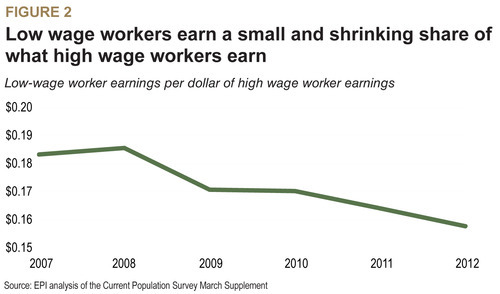June 23, 2014
Bursting the Bubble
Whether the DC regional economy is humming right along depends on your perspective.
For the region’s top earners, for example, things look pretty good: The wages of the highest-earning workers in the national capital region grew by an average of $4.11 per hour since 2007 – a gain of over $8,000 per year for a full-time, year-round worker – sending their average hourly wage to $43.
That’s nice work, if you can get it. But most workers in the region can’t.
Workers in the middle of the pack, earning the median wage of $22.07 per hour, saw a pay increase of just 16 cents per hour since 2007. And at the bottom, where people make less than $11.89 per hour, workers actually saw their hourly wages fall by 71 cents.
That means that for every dollar that a high-wage earner in the region makes, the lowest-wage earner makes just 16 cents.
This disparity makes the region’s wage gap bigger than that of any U.S. state.

Beyond income inequality, a host of other challenges confront those who live and work in the national capital region. Employment levels for people without a college education are far lower than before the recession. Unemployment rates for several groups of workers, including those without a college degree, remain high. Black workers and young workers
were particularly hard hit by the recession, even when compared to other area residents with similar education levels. And the high cost of living in the region is pushing many families to spend more than they can afford on housing, while others trade more affordable housing for long and expensive commutes.
In a new report produced jointly with the DC Fiscal Policy Institute and the Maryland Center for Economic Policy, we take a deep dive into these trends in income, employment, and housing in the core, inner and outer suburban rings of DC, including Northern Virginia and Maryland.
You can get the whole report here.
